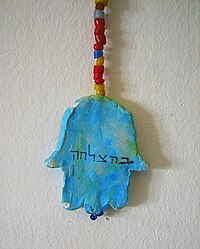as salam wbt. everytime i went out to the mall, bazaar, market etc i always pass by this logo :
it is called FATIMA HAND. i was a bit confused at first but then after googled bout it now i understand what this symbol really mean..
The hamsa (Arabic: خمسة khamsah, also romanized khamsa, meaning lit. "five") is a palm-shaped amulet popular throughout the Middle East and North Africa, and commonly used in jewellery and wall hangings.[1][2] Depicting the open right hand, an image recognized and used as a sign of protection in many societies throughout history, the hamsa provides superstitious defense against the evil eye. It is also known as the hand of Fatima, so named to commemorateMuhammad's daughter Fatima Zahra. Levantine Christians call it the hand of Mary, for the mother of Jesus. Following its incorporation into Jewish tradition via its widespread use in the Islamic world, it was also renamed the hand of Miriam for Miriam, sister of Moses. The Hand (Khamsa), particularly the open right hand, is a sign of protection that also represents blessings, power, and strength, and is seen as potent in deflecting the evil eye.
[2][16] One of the most common components of gold and silver
jewellery in the region,
[7] historically and traditionally, it was most commonly carved in
jet or formed from silver, a metal believed to represent purity and hold magical properties.
[2][17] It is also painted in red (sometimes using the blood of a sacrificed animal) on the walls of houses for protection,
[18][19] or painted or hung on the doorways of rooms, such as those of an expectant mother or new baby.
[2] The hand can be depicted with the fingers spread apart to ward off evil, or as closed together to bring good luck.
[20] Highly stylized versions may be difficult to recognize as hands, and can consist of five circles representing the fingers, situated around a central circle representing the palm.
[20]Used to protect against evil eye, a malicious stare believed to be able to cause illness, death, or just general unluckiness, hamsas often contain an eye symbol.
[21][17] Depictions of the hand, the eye, or the number five in Arabic (and
Berber) tradition are related to warding off the evil eye, as exemplified in the saying
khamsa fi ainek ("five [fingers] in your eye").
[21] Raising one's right hand with the palm showing and the fingers slightly apart is part of this curse meant "to blind the aggressor."
[18] Another formula uttered against the evil eye in Arabic, but without hand gestures, is
khamsa wa-khamis ("five and Thursday").
[22][9] As the fifth day of the week, Thursday is considered a good day for magic rites and pilgrimages to the tombs of revered saints to counteract the effects of the evil eye.
[8]The number five in Islam is connected to the open hand, the pentagram of the five senses, marriage, the
Five Pillars of Islam, the five daily prayers, and the hand of Fatima.
[2][8] Sufi staffs or poles are often topped with a khamsa.
[18] Among
Shiites, the fingers of the hand of Fatima also represent the 'five holy persons' of the Prophet's family: Muhammed, Fatima,
Ali,
Hassan, and
Hussein.
[18][2] Ali's name or those of all of
The Twelve Imams are sometimes engraved on metal Hands of Fatima.
[18] Hamsas can also include a heart, a hexagram, or the word
Allah inscribed in the palm of the hand.
[9]Due to its significance in both Arabic and Berber culture, the hamsa is one of the national symbols of
Algeria and appears in its
emblem. It is also the most popular of the different
amulets to ward off the evil eye in
Egypt — others being the Eye and the
Hirz (a silver box containing verses of the
Koran).
[7] Egyptian women who live in
baladi ("traditional") urban quarters often make
khamaysa which are amulets made up of five (
khamsa) objects to attach to their children's hair or black aprons. The five objects can be made peppers, hands, circles, or stars hanging from hooks. Black aprons are also thought to ward off the evil eye.
[19]
Clay hamsa on a wall, inscribed with the Hebrew word "behatzlacha"" - literally "Good Luck" or "In success"
With the establishment of the
State of Israel, the widespread use of the talisman by Jews who came there from Islamic countries declined precipitously. Its association with superstition was out of place in the secularly conceived state, and according to writer Alexandra Nocke, its 'Easternness' was looked down upon in the Eurocentric Ashkenazi cultural milieu that dominated.
[23]In recent decades, that trend has been reversed with the renewed Israeli interest in
Mizrahi folklore and customs and the hamsa's use is proliferating. In Israel today, it is a trendy symbol that has become "an icon of Israeliness and secularity," though its symbolism there is by no means all pervading or universal.
[23] A popular 'good luck' charm, it appears on necklaces, keychains, postcards, telephone and lottery cards, and in advertisements.
[23]It is also incorporated into high-end jewellery, decorative tilework, and wall decorations.
[23]
ada satu butik kat avenues mall, lupa plak apa nama butik tu ade huge pic of this fatima hand...amulet rupenyer...iskh...patutla bnyj accessories yang guna simbol ni...kat sini pon i perasan ramai minah2 arab ni pakai..fatima hand ni kepercayaan orang jewish so islam haram la pakai kan..tapi kuwaiti ni mane kisah haram ke hape ke...diorang main tibai je... same goes to cukur kening.. ramai minah2 arab ni cukur abis kening diorang and tampal kening palsu...heeheehee...apakah? pakai hijab, niqab n abaya but kening fail! ngan kaler kuku bagai...nauzubillah.... maybe tutup aurat ni just macam budaya yang diorang dah amalkan sejak zaman tok nenek diorang..bukan sebab tuntutan agama...wallahhualam...




















